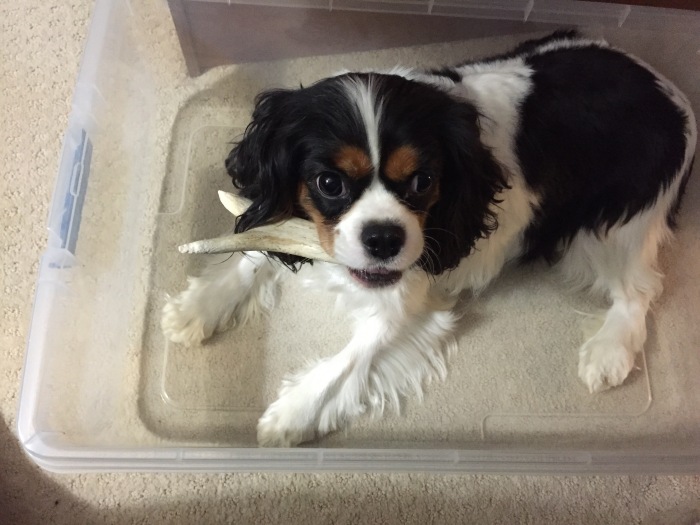As a slightly obsessed dog lover, I want everyone else to at least like my dog. That’s why I spent so much time training Bitsy to behave like a proper lady. Jumping up on guests, stealing shoes, barking excessively, and begging at the table are pet peeves I cannot tolerate in someone else’s dog. I would certainly not tolerate that behavior in my own sweet Cavalier.
Don’t get me wrong. Raising a well-behaved canine is no easy feat. But if you don’t have the time and patience for proper training, perhaps a dog is not the best pet choice. Maybe you should consider a hermit crab instead.

Tactic 1: Find what motivates your pooch.
For many dogs, food is the most effective motivator. Luckily for me, Bitsy falls into this category. Treats should be small and healthy. Examples of good training foods include raw vegetables, bits of home baked biscuits, or dry food kibbles. Ice cubes can also be a no calorie special treat!
There are many reputable websites that include more comprehensive lists of foods you should not feed your dog, but here are a few to avoid:
- Grapes
- Avocado
- Chocolate
- Dairy products
- Macadamia nuts
- Raw meat
- Raw eggs
- Onions, Garlic
- Mushrooms
- Caffeine
- Fat trimmings
- Chicken bones
Praise is an excellent motivator, both verbal and physical. A calm, positive word of encouragement or a scratch behind the ears can get some dogs to do anything you ask! You can also reinforce good behavior by using a much-loved toy or activity. If your pup goes crazy over a favorite ball, kong, or ride in the car, use those things as training tools.
Tactic 2: Nip jumping in the bud.
It doesn’t matter whether Fido weighs 5 pounds or 85 pounds. When a dog jumps up on you, it scratches your legs, covers you in dog hair, frightens, and annoys even the most reasonable people. I’ve seen many tactics to combat this unpleasant behavior. I would start with these simple tips first.

Train your dog from the very beginning to sit and stay when someone enters your home. Use the motivator that works for your dog. Start with short periods of time and increase that span in increments.
If your dog already acquired the “jump on visitors” trait, ask people who enter your home to fold their arms and turn their backs on your dog. When the dog finally figures out that jumping up will not elicit any affection, he will usually give up. When your dog returns all feet to the floor, try getting him to sit and stay. Once accomplished, hand over a treat or praise.
If the folded arms system does not take hold over time, you can try lightly stepping on the dogs back feet while his front paws are resting on the human legs (or chest). This will immediately prompt your dog to return to his own four paws. In time, he will associate jumping up with the discomfort of his back paws and cease the bad behavior.
If this last straw tactic fails, then contact a dog trainer.
I want to add here that I am not a professional dog trainer. I love dogs and have taken the time to train my own. Dog training takes time, patience, practice, and a calm spirit. Don’t expect miracles overnight. And never lose your cool.
Tactic 3: Stealing the Three S’s – Shoes, Slippers, Socks
Have you ever wondered why some dogs take your house guest’s shoe the moment they leave it at your front door? Or why she runs through the house with your bedroom slipper hanging from her mouth? Does your pooch confiscate more single socks than your dryer?
Could it be she gets your attention every time she takes something you’ve forbidden? In my opinion, dogs just want to love and be loved. If you make a big deal out of chasing her down when she steals something, it becomes a game and a source of attention. Use treats to reward her for not taking shoes, slippers, or socks when you put them within easy reach to tempt her. You should also ensure your dog has her own toys for entertainment.
Confession: Bitsy loves it when she finds one of my dirty socks. She does not chew it, but relishes in running away when I see it dangling from her mouth. Funny, but she never takes the clean ones!
If your dog is taking your shoes and chewing them, that is a more serious behavior issue than poor manners. I recommend reading Cesar Millan’s website for shoe chewing and other problematic behaviors.
Tactic 4: Halt Excessive Barking
It is difficult to speak with a house guest or talk to your neighbor through the back fence when your dog is overtaking the conversation with loud, obnoxious barking.

As with jumping up or stealing slippers, never reward your dog with attention for unacceptable behavior. Remain calm and ignore an overly excited dog. Affection and attention should only be paid to an equally calm dog. This is much more difficult to achieve if you’ve rescued a dog that already developed the barking habit. Don’t get frustrated. Remember what I wrote at the end of Tactic 2!
I am not a fan of those barking collars. I’m not passing judgement on anyone who successfully uses them to train their dog. It’s just not my personal preference.
Tactic 5: Do Not Teach Begging!
Here is where I am going to pass judgement. If your dog begs at the table, you are one hundred percent to blame. It is an owner-created bad habit. (On my soapbox now.) If you only feed your dog dog food and healthy snacks as training aids, your dog will not beg for people food from the table. I’m not sure how I could explain that more simply or explicitly! This is a hard habit to break, so don’t go down that road in the first place. If you inherited a dog that begs at the table, then work with her to overcome the habit by ignoring it and not feeding her from the table.
Dogs are much easier to train than children, or so I’m told! Be patient. It takes time to break bad habits. Be positive. Your dog only wants to make you happy. Most importantly, start your dog out with firm boundaries and good manners from the start. That way, your family, friends, and guests will love your prized pet as much as you do. Well, almost!
Thanks for the handy tips! I find it really hard to ignore an exciting pup but it makes sense that attention encourages barking and jumping up. I’ll keep working on that with my little Rufus 🙂
LikeLiked by 1 person
Things are always easier said than done! You will note that Bitsy still steals my dirty socks whenever I turn my back!
LikeLiked by 1 person
Happy to help! Stay tuned! 🙂
LikeLike
Hi Brad! Bitsy is ADORABLE!!!!!! I have a huge favor! Will you add “follow by email” to your sidebar? Would love to follow you and that is my preferred way to follow! DakotasDen
LikeLiked by 1 person
Great advice, and I especially relate to the jumping behavior. It does seem that some owners tend to let their dogs get away with more when they’re small, but that certainly doesn’t mean the behavior is appropriate.
And when it comes to begging you are correct. It takes a long time to break them of that habit if they’ve gotten away with it before, but with patience it can be done just by ignoring it.
LikeLiked by 1 person
Thanks Jen!
LikeLike